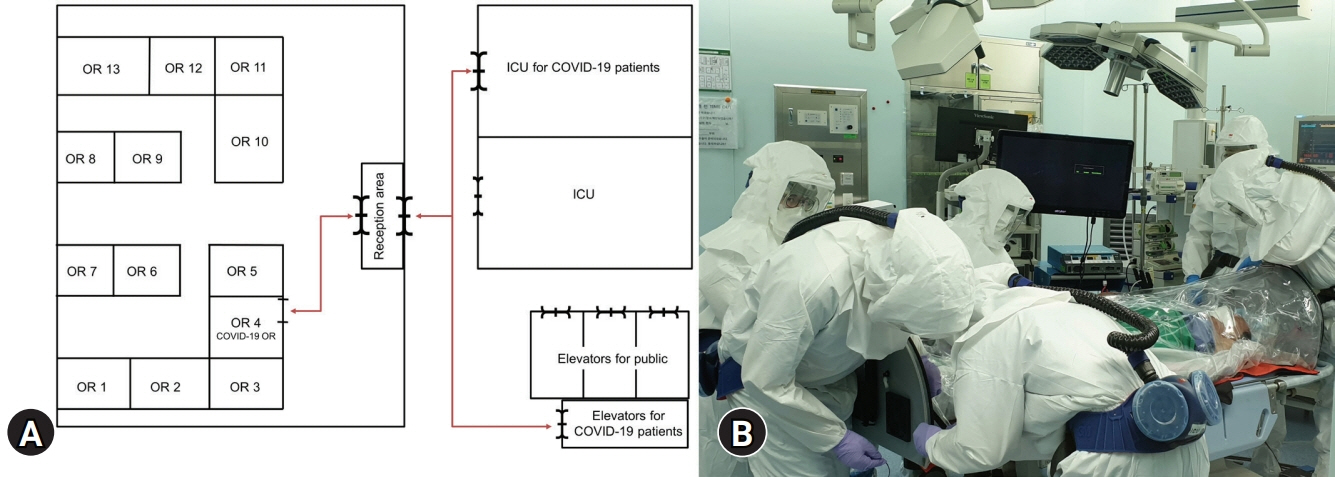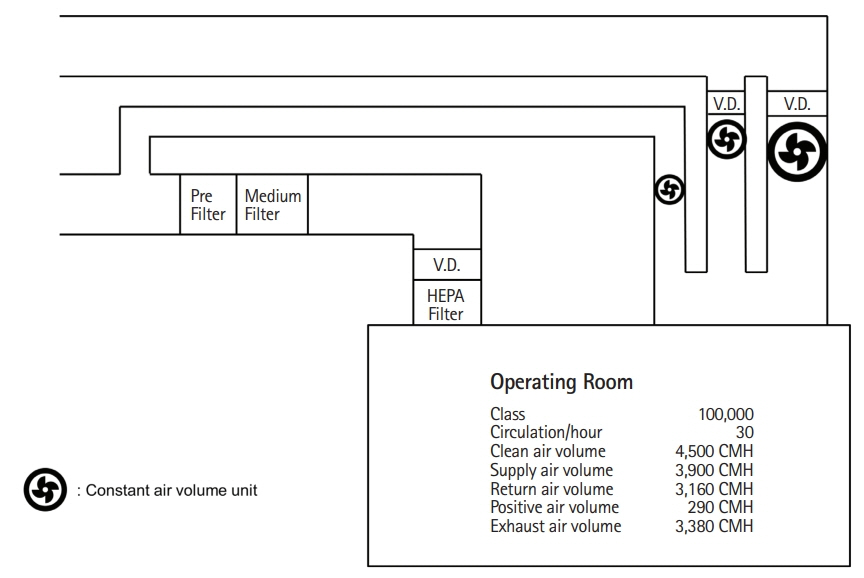J Yeungnam Med Sci.
2022 Jul;39(3):223-229. 10.12701/yujm.2021.01431.
Infection prevention measures and outcomes for surgical patients during a COVID-19 outbreak in a tertiary hospital in Daegu, South Korea: a retrospective observational study
- Affiliations
-
- 1Department of Anesthesiology and Pain Medicine, Kyungpook National University Chilgok Hospital, School of Medicine, Kyungpook National University, Daegu, Korea
- 2Department of Internal Medicine, School of Medicine, Kyungpook National University, Daegu, Korea
- KMID: 2532075
- DOI: http://doi.org/10.12701/yujm.2021.01431
Abstract
- Background
The first large coronavirus disease 2019 (COVID-19) outbreak outside China occurred in Daegu. In response, we developed infection prevention measures for surgical patients during the outbreak at our hospital and retrospectively reviewed the outcomes of COVID-19–related surgical patients.
Methods
We reviewed the medical records of 118 COVID-19–related surgical patients and monitored their clinical outcomes until March 31, 2021. We also interviewed healthcare workers who participated in their perioperative care at Kyungpook National University Chilgok Hospital. The perioperative management guidelines for COVID-19–related patients were prepared through multidisciplinary discussions, including the infection control department, surgical departments, and anesthesiology department before and during the COVID-19 outbreak.
Results
One standard operating room was temporarily converted to a negative-pressure room by increasing the exhaust air volume, creating a relative pressure of −11.3 Pa. The healthcare workers were equipped with personal protective equipment according to the patient's classification of the risk of COVID-19 transmission. The 118 COVID-19–related patients underwent emergent surgery in the negative-pressure room, including three COVID-19–confirmed patients and five COVID-19–exposed patients.
Conclusion
All surgeries of the COVID-19–related patients were performed without specific adverse events or perioperative COVID-19 transmission. Our experience setting up a negative-pressure operating room and conservative perioperative protocol to prevent COVID-19 transmission will help plan and execute infection control measures in the future.
Keyword
Figure
Reference
-
References
1. Kim SW, Lee KS, Kim K, Lee JJ, Kim JY; Daegu Medical Association. A brief telephone severity scoring system and therapeutic living centers solved acute hospital-bed shortage during the COVID-19 outbreak in Daegu, Korea. J Korean Med Sci. 2020; 35:e152.
Article2. Korea Disease Control and Prevention Agency. The Korea Centers for Disease Control and Prevention [Internet]. Cheongju: Korea Disease Control and Prevention Agency;[cited 2021 May 14]. http://ncov.mohw.go.kr/index_main.jsp.3. Chee VW, Khoo ML, Lee SF, Lai YC, Chin NM. Infection control measures for operative procedures in severe acute respiratory syndrome-related patients. Anesthesiology. 2004; 100:1394–8.
Article4. Zucco L, Levy N, Ketchandji D, Azia M, Ramachandran SK. Perioperative considerations for the 2019 novel coronavirus (COVID-19) [Internet]. Rochester, MN: Anesthesia Patient Safety Foundation;2020. Feb. 12. [cited 2021 Apr 21]. https://www.apsf.org/news-updates/perioperative-considerations-for-the-2019-novel-coronavirus-covid-19/.5. Lauer SA, Grantz KH, Bi Q, Jones FK, Zheng Q, Meredith HR, et al. The incubation period of coronavirus disease 2019 (COVID-19) from publicly reported confirmed cases: estimation and application. Ann Intern Med. 2020; 172:577–82.
Article6. Chow TT, Kwan A, Lin Z, Bai W. Conversion of operating theatre from positive to negative pressure environment. J Hosp Infect. 2006; 64:371–8.
Article7. Sehulster L, Chinn RY. Guidelines for environmental infection control in healthcare facilities: recommendations of CDC and the Healthcare Infection Control Practices Advisory Committee (HICPAC) [Internet]. Atlanta: Centers for Disease Control and Prevention;2003. [cited 2021 Apr 21]. https://www.cdc.gov/mmwr/preview/mmwrhtml/rr5210a1.htm.
Article8. Choi S, Ki M. Estimating the reproductive number and the outbreak size of COVID-19 in Korea. Epidemiol Health. 2020; 42:e2020011.
Article9. Wang X, Zhou Q, He Y, Liu L, Ma X, Wei X, et al. Nosocomial outbreak of COVID-19 pneumonia in Wuhan, China. Eur Respir J. 2020; 55:2000544.
Article10. Nishiura H, Kobayashi T, Miyama T, Suzuki A, Jung SM, Hayashi K, et al. Estimation of the asymptomatic ratio of novel coronavirus infections (COVID-19). Int J Infect Dis. 2020; 94:154–5.
Article11. Gudbjartsson DF, Helgason A, Jonsson H, Magnusson OT, Melsted P, Norddahl GL, et al. Spread of SARS-CoV-2 in the Icelandic population. N Engl J Med. 2020; 382:2302–15.
Article12. Wang W, Xu Y, Gao R, Lu R, Han K, Wu G, et al. Detection of SARS-CoV-2 in different types of clinical specimens. JAMA. 2020; 323:1843–4.
Article13. He X, Lau E, Wu P, Deng X, Wang J, Hao X, et al. Temporal dynamics in viral shedding and transmissibility of COVID-19. Nat Med. 2020; 26:672–5.
Article14. Yeo C, Kaushal S, Yeo D. Enteric involvement of coronaviruses: is faecal-oral transmission of SARS-CoV-2 possible? Lancet Gastroenterol Hepatol. 2020; 5:335–7.
Article15. World Health Organization (WHO). Modes of transmission of virus causing COVID-19: implications for IPC precaution recommendations [Internet]. Geneva: WHO;2020. [cited 2021 Apr 28]. https://www.who.int/news-room/commentaries/detail/modes-of-transmission-of-virus-causing-covid-19-implications-for-ipc-precaution-recommendations.16. Bai Y, Yao L, Wei T, Tian F, Jin DY, Chen L, et al. Presumed asymptomatic carrier transmission of COVID-19. JAMA. 2020; 323:1406–7.
Article17. Zou L, Ruan F, Huang M, Liang L, Huang H, Hong Z, et al. SARS-CoV-2 viral load in upper respiratory specimens of infected patients. N Engl J Med. 2020; 382:1177–9.
Article18. van Doremalen N, Bushmaker T, Morris DH, Holbrook MG, Gamble A, Williamson BN, et al. Aerosol and surface stability of SARS-CoV-2 as compared with SARS-CoV-1. N Engl J Med. 2020; 382:1564–7.
Article19. Brown J, Gregson F, Shrimpton A, Cook TM, Bzdek BR, Reid JP, et al. A quantitative evaluation of aerosol generation during tracheal intubation and extubation. Anaesthesia. 2021; 76:174–81.
Article20. Public Health England. Infection control precautions to minimise transmission of acute respiratory tract infections in healthcare settings [Internet]. Public Health England: London;2016. [cited 2021 Sep 16]. https://www.gov.uk/government/publications/respiratory-tract-infections-infection-control.21. Tompkins BM, Kerchberger JP. Special article: personal protective equipment for care of pandemic influenza patients: a training workshop for the powered air purifying respirator. Anesth Analg. 2010; 111:933–45.22. Bischoff WE, Turner J, Russell G, Blevins M, Missaiel E, Stehle J. How well do N95 respirators protect healthcare providers against aerosolized influenza virus? Infect Control Hosp Epidemiol. 2019; 40:232–4.
Article
- Full Text Links
- Actions
-
Cited
- CITED
-
- Close
- Share
- Similar articles
-
- The feasibility of organ transplantation during the COVID-19 outbreak: experiences from South Korea
- COVID-19 Public Health Measures During National Assembly Elections of the Republic of Korea
- Experience of Treating Critically Ill COVID-19 Patients in Daegu, South Korea
- Lesson from COVID-19 outbreak; importance of standard precautions to febrile neutropenia prevention in patients with breast cancer who received adjuvant chemotherapy: a retrospective observational study
- Impact of the COVID-19 outbreak on adult out-of-hospital cardiac arrest outcomes in Daegu, South Korea: an observational study



